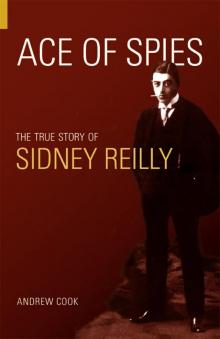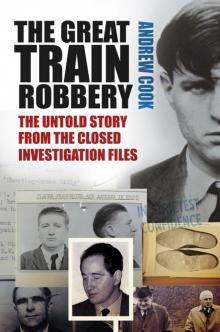- Home
- Andrew Cook
Ace of Spies Page 6
Ace of Spies Read online
Page 6
With his knowledge of the impending Japanese attack, now possibly only months away, he insisted that a town under siege was no place for Margaret and had her pack her things and return to England. In the autumn of 1903 she left Port Arthur for Yokohama, then journeyed to Europe across the Pacific, via San Francisco and New York.12 Now free to continue his dalliance with Anna unhindered, their affair began to attract attention. Whether this was another relationship of short-term convenience, or the beginning of a much longer term liaison depends very much on how one interprets Reilly’s connections with the Japanese and his own hasty departure from Port Arthur the following year.
His undoubted knowledge of Japanese intentions would later lead to questions being raised about his role in Port Arthur and the allegation that he was in fact a spy in the pay of the Japanese. Authors Winfried Ludecke and Richard Deacon state clearly their view that Reilly was a Japanese spy,13 while Robin Bruce Lockhart portrays Reilly as being distinctly anti-Japanese in his account of events.14 Professor Ian Nish, of the London School of Economics, and author of Causes of the Russo-Japanese War, is therefore right to refer to Reilly’s role as ‘one of the unsolved riddles about the Russo-Japanese War’.15
The first known and recorded suggestion that Reilly had been a Japanese spy is contained within a US Bureau of Investigation report written by Agent L. Perkins on 3 April 1917.16 Written while Reilly was living in New York during the First World War, the report refers to information volunteered to the Bureau by one Winfield Proskey, an engineer with the Flint Arms Company, who stated that Capt. Guy Gaunt,17 the British Naval attaché in New York, had told him that Sidney Reilly had once spied for Japan. Gaunt was certainly in Manchuria at the time the Russo-Japanese War broke out, where he was serving on HMS Vengeance in the summer of 1904.18 It is, therefore, not unlikely that Gaunt either encountered Reilly while in Manchuria or had heard stories of his alleged spying there.
Although Richard Deacon’s stated belief that Reilly’s Japanese intelligence contact was Col. Akashi Motojiro is not supported by Akashi’s own records,19 a letter written by Reilly to an unknown correspondent simply referred to as ‘ECF’, on 3 December 1902, does clearly suggest that he did have an interest and knowledge of intelligence matters at this time:
The Manchu’s are finished. It is only a matter of time before China becomes the playground of the great powers. Their intelligence service, such as it is, for all practical purposes simply does not exist. But I should warn you that in this vacuum which is left a new and much more dangerous Secret Service will eventually spring up. Today it is like a sperm in the womb. Tomorrow? Perhaps a fully fledged child.20
Although not stated openly in the letter, the ‘sperm in the womb’ can only mean the Japanese Secret Service, who had a growing network of agents in Manchuria at this time to help them gauge Russian intentions. Britain was also keeping a watching brief on developments in the area through its Military and Naval Intelligence Departments with a view to her future policy. Her first preference would have been an agreement with the Russians to preserve the status quo in the region. Unable to achieve this objective, Britain concluded a treaty with Japan in January 1902, by which she hoped to achieve the next best thing. At the time of the treaty, the Japanese had six capital ships, Russia six, France six and Britain four. Under the treaty, Britain or Japan would come to the other’s aid in the event of one of them being at war with more than one of the other great powers. Should Japan be unable to get the Russians to come to some agreement concerning their ongoing expansionism, the treaty would at least now make it possible for Japan to contemplate war with Russia as a last resort, in the full knowledge that the French would be kept in check by the British.
Understandably, Britain took a greater degree of interest after the treaty and particularly as tensions between the Russians and the Japanese were seen to be heightening. War Office Military Intelligence records confirm that in 1903, ‘the first four officers were sent to Japan as language students’.21 The thrust of Britain’s intelligence gathering was therefore through the armed forces, although this is not to discount information picked up by diplomatic posts and newspaper correspondents. Russian espionage files, for example, refer to a Daily Telegraph corres-pondent in Manchuria, a retired lieutenant colonel, Joseph Newman, who appears to have been well connected within the European business community.22 He would, more than likely, have relayed back anything of interest he had heard and could well have come across Reilly during his stint in Manchuria. Whoever Reilly was supplying information to, it was certainly not the Russians. While not expecting to lose any future conflict with Japan, they were certainly sensitive to Japanese efforts to obtain information about Port Arthur and were keen to keep a watchful eye on those suspected of being foreign spies, particularly among the European residents of Port Arthur. Comprehensive records still exist in Moscow, providing a wealth of detail about the numerous agents they themselves were running in Port Arthur and in the region generally.23 Reilly’s name is nowhere to be seen.
When the inevitable conflict between Russia and Japan broke out into open hostility on 8 February 1904, it was as a result of a surprise Japanese attack against the Russian Pacific fleet at Port Arthur. With no declaration of war prior to the attack, it bore many of the hallmarks that would characterise the assault on the American Pacific fleet at Pearl Harbor some thirty-six years later. Although the attack on Pearl Harbor was carried out in daylight by air and the attack on Port Arthur was at night by torpedo boats, the theory behind both acts of war was the same. The Japanese had calculated that the only possible way they could defeat a larger and theoretically stronger power was by attacking without warning and in so doing striking a blow from which the enemy would have great difficulty recovering.
As a result of superior intelligence, Japan’s Admiral Togo was not only aware of the positions of all Russian ships but was equally aware of the layout of Russian minefields and search-light locations. This enabled the Japanese to move through the minefields unhindered and to emerge from the darkness unseen by Port Arthur’s search lights, which on the night of the attack were mysteriously disabled. Although Togo’s attack succeeded in crippling the Russian Pacific fleet, it was not until 1 January 1905 that the Japanese actually captured the port. Neither side had foreseen the lengthy siege of Port Arthur and the Japanese in particular were not prepared for a winter campaign. Although ultimately victorious, 58,000 Japanese lives were lost in comparison to the 31,000 Russians who perished defending the town.
Credit for Togo’s initial attack on Port Arthur, which was one of the most brilliantly conceived and co-ordinated assaults ever undertaken, was very much the result of the advance intelligence operation which enabled him to access Russian defence plans. How he managed to obtain these has been shrouded in mystery for nearly a century. When the US army, led by Gen. MacArthur, arrived in Japan in August 1945, it set about examining Japanese intelligence records. A large consignment of material was taken away by MacArthur’s intelligence chief, Gen. Willoughby, and sent to Washington for detailed analysis. Students of the Russo- Japanese War hoped that here at last would be revealed the answer to the mystery. Sadly, no hint as to the identity of the agent who procured the plans for Togo was ever found in the records, copies of which now reside in America’s National Archives in Washington DC. As a result, it was widely assumed that the solution to the riddle had been lost or destroyed.
In Moscow’s Military Historical Archives 6,000 miles away, however, a dusty file of intelligence reports finally exposes the Russians’ number-one suspect. The file, not seen by unauthorised eyes before the downfall of Soviet communism, contains a report from April 1904 addressed to ‘His Excellency the Commandant of Port Arthur’ and marked ‘Secret’.24 In it, the conclusions of an in-depth investigation into the theft of harbour defence plans are revealed, and the culprit named as one Ho-Liang-Shung, a Chinese engineer who worked under the Head Marine Architect, Svirsky. Ho-Liang-Shung had a detailed knowledge of the harbour
, its fortifications and mine field. He also had access to the harbour defence plans. According to the report, he had prior knowledge of the Japanese attack as early as 26 January 1904. On 23 February and again on 8 March, large sums of money were deposited into his bank account. On 10 April he attempted to leave without an exit permit and was detained by the port gendarme. In spite of this, he managed to escape confinement and was never seen again.
While convinced of Ho’s guilt, the Russians were clearly of the view that he had not acted alone and was very much a minor player in a wider web. The identity of his ‘go-between’, the person to whom he had given the plans and who had paid the money into his bank account, was never established. Intriguingly, some twenty-seven years later, when Margaret Reilly wrote a manu-script about her husband’s life, she referred in passing to a port engineer acquaintance he had known in Port Arthur – ‘Ho-Ling-Chung’.25 While the spellings are at variance, the chances of there being two engineers with such similar names, moving in similar circles, must be viewed as somewhat remote. Bearing in mind the intimate relationship between Ginsburg & Company and the Pacific fleet, it is highly probable that Reilly would have come into regular contact with port and naval officials at all levels. In fact, many of the naval contacts he utilised in later years were initially made during his time in Port Arthur.
Reilly and Ho are further linked by their mutual disappearance, for shortly after Ho’s escape, Reilly too departed. In 1917 Moisei Ginsburg recalled that Reilly had ‘suddenly vanished’, leading the local Russians to conclude that he was a spy.26 Winfried Ludecke and Richard Deacon have both maintained that Reilly concluded the Russians had their suspicions about him after discovering someone associated with East-Asiatic was in the employ of Russian intelligence.27 This theory again finds corroboration in Moscow archives, which reveal that one of Russia’s most valuable espionage finds was a British citizen by the name of Horace Collins who indeed happened to work for the East-Asiatic Company. Collins was born on 12 March 1870 in Hever, Kent.28 His father was a well-to-do farmer, and Horace grew up working with horses, eventually taking up an apprenticeship as a jockey at the nearby Lingfield stables. On completion of his apprenticeship in 1893 he went to the Far East, where he eventually secured a job at the stables of the Japanese Emperor. It was during this period that he learnt to speak Japanese and a Chinese language. Although moderately successful as a jockey, it was not long before he took to business, making the most of his oriental languages and travelling widely on behalf of various trading houses in China, Korea, Japan and eastern Russia.
There is no indication in Russian records as to how Collins was recruited as a spy, although money may well have been a factor. It would seem from the commentary in his file that he was not exactly prospering in business when he was first recruited. From the Russian point of view, he was most useful by virtue of his language abilities and his knowledge of Japan and her people. Accordingly, the Russians were paying him $300 per month plus expenses.29
Whether Reilly’s discovery of the Russian agent was made by chance or through a third party is unknown. However, bearing in mind the suggestion that he was involved in an affair with a woman by the name of Anna, one candidate stands out in particular – Anna Grigoryevna Collins, Horace Collins’ Russian-born wife.30 She not only knew of his work for the Russians, but was also known to be having an affair with an associate of her husband.
Having made a swift exit from Port Arthur, Winfried Ludecke suggests that Reilly headed for Japan in the company of ‘a lady with whom he had been flirting’.31 Whether Anna and the lady companion are one and the same is conjecture. If Reilly did go to Japan, he could not have stayed there very long, for in June 1904 we find him in Paris.32 During the brief time he spent in the city he renewed his acquaintance with William Melville, whom he had last seen in 1899, shortly before his hurried departure from London. Reilly’s meeting with Melville is most significant, for within a matter of weeks Melville was to enlist his help in what would later become known as the D’Arcy Affair.
Authors writing about Reilly’s role in the D’Arcy Affair have often relied on Reilly’s own tale of what happened. Other sources lead to a rather different train of events. The background to the affair is succinctly set out in a letter of reminiscence dated 30 April 1919 from E.G. Pretyman MP to Sir Charles Greenway, the chairman of The Anglo-Iranian Oil Company,33 in which Pretyman recounts his own involvement some fifteen years earlier, as Civil Lord of the Admiralty, in securing the Persian oil concession for Britain, which led indirectly to the founding of the Anglo-Iranian Oil Company:
In 1904 it became obvious to the Board of the Admiralty that petroleum would largely supersede coal as the source of fuel supply to the Navy. It was also clear to us that this would place the British Navy at a great disadvantage, because, whereas we possessed, within the British Isles, the best supply of the best steam coal in the world, a very small fraction of the known oilfields of the world lay within the British Dominions, and even those were situated in very distant and remote regions. Lord Selborne therefore decided to appoint a small Standing Committee to deal with this question and to take any steps they found possible to bring additional sources of petroleum supply under British control. I was appointed Chairman of this Committee and was assisted by Sir Boverton Redwood and the late Sir Henry Gordon Miller, then Mr Gordon Miller, Director of Navy Contracts. In the course of our investigations we learned through Sir Boverton Redwood that the late Mr D’Arcy had secured a valuable concession from the Persian government of the oil rights in southern Persia, and that he was negotiating for a similar concession from the Turkish Government for oil rights in Mesopotamia. We also ascertained that Mr D’Arcy was desirous of disposing of his rights under the Persian Concession to some financial Syndicate with the necessary capital and experience to undertake development operations. We further ascertained that D’Arcy was, at that moment, in the Riviera negotiating for the transfer of his concession to the French Rothschilds. I therefore wrote to Mr D’Arcy explaining to him the Admiralty’s interest in petroleum development and asking him, before parting with the concession to any foreign interests, to give the Admiralty an opportunity of endeavouring to arrange for its acquisition by a British Syndicate.
I further asked him to come and see me on the subject. Mr D’Arcy accepted my invitation and returned from the Riviera to discuss the position with me. As a result of our conversation, the Committee approached the Burmah Oil Company with whom arrangements had already been made for emergency supplies of Naval Oil fuel, and, after investigating the prospects of the Persian Oil Field, they agreed to undertake its development and to form a Syndicate.
D’Arcy had already spent over £150,000 in the search for oil over and above what he had spent in obtaining the concession in the first place. It was clear that he could not continue in this way. He soon found, however, that he was very much in a ‘chicken and egg’ position, as potential backers, including the British government, would have nothing to do with the project until oil was found. Then, in December 1903, there seemed to be hope in that Lord Rothschild, who had heard of D’Arcy’s venture, had expressed the view that it was of ‘great importance’. D’Arcy’s intermediary, Sir Arthur Ellis, met with Lord Rothschild and on 30 December wrote to D’Arcy to inform him that Rothschild would be writing to his cousin Baron Alphonse de Rothschild in Paris. It was indicated to the Rothschilds by Sir Arthur Ellis that £2 million would have to be spent in Persia. A personal meeting was therefore arranged between D’Arcy, who was accompanied by John Fletcher Moulton, and Baron de Rothschild in Cannes. According to the records of the Anglo-Iranian Oil Company, this meeting took place towards the end of February 1904.34
Pretyman’s letter also raises a number of other questions: why, for example, had the British government had such a quick and fundamental change of heart in now wanting to assist D’Arcy? Back in November of the previous year they had shown a distinct lack of enthusiasm for assisting him. Now, three short months later, they
had not only a dramatic change of mind but were positively pursuing him to the negotiating table.
It may well be that in December 1903 the government view was that in the absence of any other potential D’Arcy backers they could afford to wait for a sign of the concession’s potential before committing any money. The situation changed dramatically the following month, however, when it seemed not only that D’Arcy had now found potential funding, but that potential funding was sourced abroad and might purchase the concession outright.
In Ace of Spies, Robin Bruce Lockhart repeats one of Reilly’s oft-recited tales of how, at the British Admiralty’s behest, he tracked down D’Arcy and covertly approached him in the south of France. According to Reilly, he boarded de Rothschild’s yacht disguised as a priest and persuaded D’Arcy to break off negotiations and return to London to meet with Pretyman and the Admiralty.35 This story is clearly fantasy on Reilly’s part, for in February 1904 he was thousands of miles away in Port Arthur. However, this should not discredit the theory that the Admiralty was engaged in efforts to entice D’Arcy from the clutches of the Rothschilds.
As D’Arcy and the Rothschilds were making the first tentative moves towards exploratory talks, William Melville mysteriously resigned as head of Special Branch on 1 December 1903. No known reason was given for his sudden departure. His Metropolitan Police Service File would have contained the answer to this puzzle, but unlike those of other Special Branch heads, it is no longer to be found. Had he made too many anarchist enemies, and decided to disappear from view, or had he accepted a lucrative position outside the force? All the signs are that this was a speedy and unplanned departure. Patrick Quinn was appointed to succeed him, and as an indication of the haste involved, was promoted to superintendent without sitting the usual examination, which he would have done well in advance if his promotion had been planned and anticipated.

 M
M Ace of Spies
Ace of Spies The Great Train Robbery
The Great Train Robbery The Ian Fleming Miscellany
The Ian Fleming Miscellany